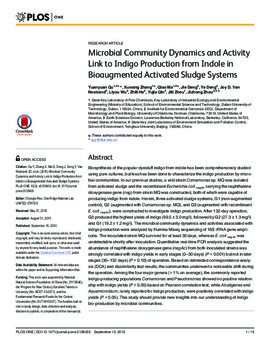| dc.contributor.author | Yuanyuan Qu | |
| dc.contributor.author | Xuwang Zhang | |
| dc.contributor.author | Qiao Ma | |
| dc.contributor.author | Jie Deng | |
| dc.contributor.author | Ye Deng | |
| dc.contributor.author | Joy D. Van Nostrand | |
| dc.contributor.author | Liyou Wu | |
| dc.contributor.author | Zhili He | |
| dc.contributor.author | Yujia Qin | |
| dc.contributor.author | Jiti Zhou | |
| dc.contributor.author | Jizhong Zhou | |
| dc.date.accessioned | 2017-03-05T22:55:12Z | |
| dc.date.available | 2017-03-05T22:55:12Z | |
| dc.date.issued | 2015-09-15 | |
| dc.identifier.citation | Qu Y, Zhang X, Ma Q, Deng J, Deng Y, Van Nostrand JD, et al. (2015) Microbial Community Dynamics and Activity Link to Indigo Production from Indole in Bioaugmented Activated Sludge Systems. PLoS ONE 10(9): e0138455. doi:10.1371/journal.pone.0138455 | en_US |
| dc.identifier.uri | https://hdl.handle.net/11244/49273 | |
| dc.description | | en_US |
| dc.description | | en_US |
| dc.description.abstract | Biosynthesis of the popular dyestuff indigo from indole has been comprehensively studied using pure cultures, but less has been done to characterize the indigo production by microbial communities. In our previous studies, a wild strain Comamonas sp. MQ was isolated from activated sludge and the recombinant Escherichia coli nagAc carrying the naphthalene dioxygenase gene (nag) from strain MQ was constructed, both of which were capable of producing indigo from indole. Herein, three activated sludge systems, G1 (non-augmented control), G2 (augmented with Comamonas sp. MQ), and G3 (augmented with recombinant E. coli nagAc), were constructed to investigate indigo production. After 132-day operation, G3 produced the highest yields of indigo (99.5 ± 3.0 mg/l), followed by G2 (27.3 ± 1.3 mg/l) and G1 (19.2 ± 1.2 mg/l). The microbial community dynamics and activities associated with indigo production were analyzed by Illumina Miseq sequencing of 16S rRNA gene amplicons. The inoculated strain MQ survived for at least 30 days, whereas E. coli nagAc was undetectable shortly after inoculation. Quantitative real-time PCR analysis suggested the abundance of naphthalene dioxygenase gene (nagAc) from both inoculated strains was strongly correlated with indigo yields in early stages (0–30 days) (P < 0.001) but not in later stages (30–132 days) (P > 0.10) of operation. Based on detrended correspondence analysis (DCA) and dissimilarity test results, the communities underwent a noticeable shift during the operation. Among the four major genera (> 1% on average), the commonly reported indigo-producing populations Comamonas and Pseudomonas showed no positive relationship with indigo yields (P > 0.05) based on Pearson correlation test, while Alcaligenes and Aquamicrobium, rarely reported for indigo production, were positively correlated with indigo yields (P < 0.05). This study should provide new insights into our understanding of indigo bio-production by microbial communities. | en_US |
| dc.language.iso | en_US | en_US |
| dc.publisher | PLos One | |
| dc.relation.ispartofseries | PLoS ONE 10(9): e0138455 | |
| dc.relation.uri | http://www.plosone.org/article/info%3Adoi%2F10.1371%2Fjournal.pone.0138455 | |
| dc.rights | Attribution 3.0 United States | |
| dc.rights.uri | https://creativecommons.org/licenses/by/3.0/us/ | |
| dc.subject | Indoles,Sludge,Naphthalenes,Pseudomonas,Ribosomal RNA,Pure culture,Sequence databases,Shannon index | en_US |
| dc.title | Microbial Community Dynamics and Activity Link to Indigo Production from Indole in Bioaugmented Activated Sludge Systems | en_US |
| dc.type | Research Article | en_US |
| dc.description.peerreview | Yes | en_US |
| dc.description.peerreviewnotes | http://www.plosone.org/static/editorial#peer | en_US |
| dc.identifier.doi | 10.1371/journal.pone.0138455 | en_US |
| dc.rights.requestable | false | en_US |

